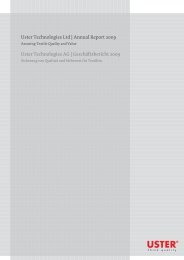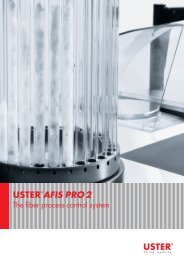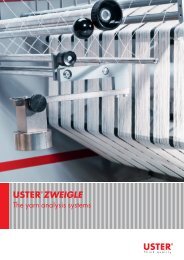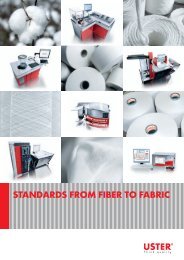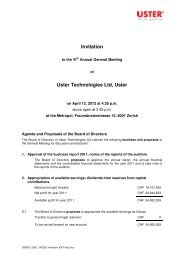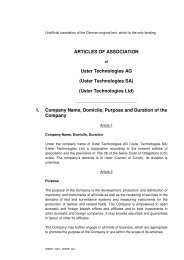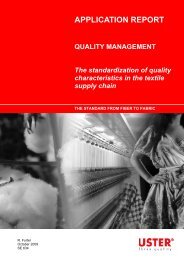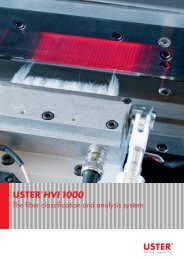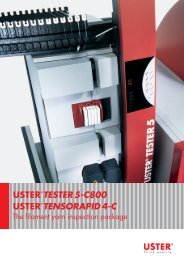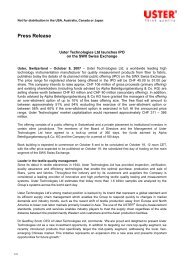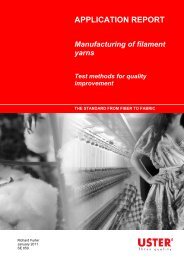Application Handbook_Uster_Statistics - Uster Technologies
Application Handbook_Uster_Statistics - Uster Technologies
Application Handbook_Uster_Statistics - Uster Technologies
- No tags were found...
Create successful ePaper yourself
Turn your PDF publications into a flip-book with our unique Google optimized e-Paper software.
Furthermore, trash removal efficiency in mill processing is not only a function of the absolute amountof trash in the raw material but also of the general cleanability of a cotton mix, which is related to boththe fiber properties and the post-harvest processing history of the cottons. These factors should bethoroughly investigated before making adjustments in the process or at individual machines.Proper calibration of the instrument is a necessary prerequisite to make correct comparisons betweenthe actual AFIS ® measurements and the USTER ® STATISTICS on fiber processing. The calibration ofan AFIS ® should be left to authorized <strong>Uster</strong> <strong>Technologies</strong> service personnel. We recommend thatreference samples, e.g. round test samples, be used to monitor the consistency of the measurementsand to contact the nearest <strong>Uster</strong> <strong>Technologies</strong> service station if unexpected changes or long-term driftshould occur. The ICA Bremen, Germany, conducts USTER ® AFIS & USTER ® HVI round tests on aninternational basis. CSITC is also conducting international round tests for USTER ® HVI instruments.Participation in such programs is highly recommended for closely monitoring the performance of theinstrument, i.e. the consistency of the measurements and the compatibility with other laboratories.This, of course, includes compatibility with the USTER ® STATISTICS as well.Nep testing with the USTER ® AFIS system is a standardized procedure and is described in detail inASTM D-5866. Further explanations of the individual functional elements of the system, thesignificance of the measurements, and the proper calibration and operation of the instrument aregiven in the operating instructions. Adequate sample conditioning and maintaining constant standardatmospheric conditions in the laboratory during testing is important.4.3 Sliver TestingThe USTER ® STATISTICS for slivers are based on measurements determined on-line. The datashown in the USTER ® STATISTICS 2013 were completed in 2008.The sliver measurement data provided in these USTER ® STATISTICS have been determined withUSTER ® SLIVERGUARD, which is comparable to the USTER ® TESTER with regard to measuringaccuracy. The quick response USTER ® FP-SENSOR permits sliver measurements that areequivalent to those carried out offline with the USTER ® TESTER in the laboratory. In practice, andprovided the above-mentioned sliver delivery aspects are kept in mind, the results of the USTER ®SLIVERGUARD can therefore be compared with the measurements of the USTER ® TESTER. TheUSTER ® STATISTICS on sliver mass variation include graphs on the coefficient of variation of slivermass (CV m , CV m (1m), CV m (3m), CV m (10m)).Proper maintenance of the USTER ® SLIVERGUARD is a necessary prerequisite to make correctcomparisons between the actual measurements and the USTER ® STATISTICS on sliver massvariation. If the customer is in possession of the “USTER ® FP-MT test set”, he can carry out thecalibration of the USTER ® SLIVERGUARD himself. Otherwise, it should be left to authorized <strong>Uster</strong><strong>Technologies</strong> service personnel. Further explanations of the individual functional elements ofUSTER ® online systems for the measurement of sliver mass variation, the significance of themeasurements, and the proper calibration and operation of the systems are given in the respectiveoperation instructions and <strong>Application</strong> <strong>Handbook</strong>s.Characteristics Abbreviation Unit DescriptionCoefficient of variation of mass CV m % Coefficient of variation of the yarn mass (Fig. 4-4)Coefficient of variation of mass atdifferent cut lengthsCV m (L) % Coefficient of variation of the yarn mass at cut lengthsof 1 m, 3 m, 10 mTable 4-7USTER ® STATISTICS 17 (36)



